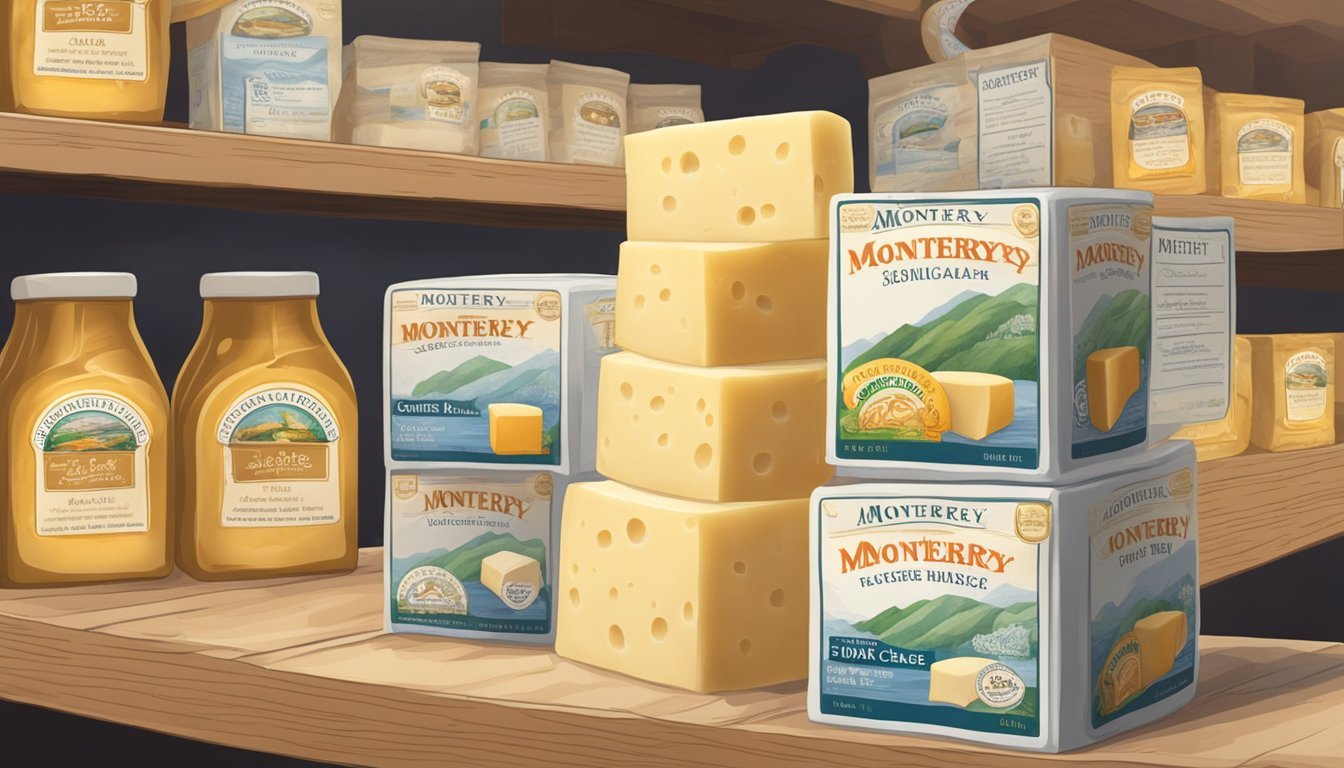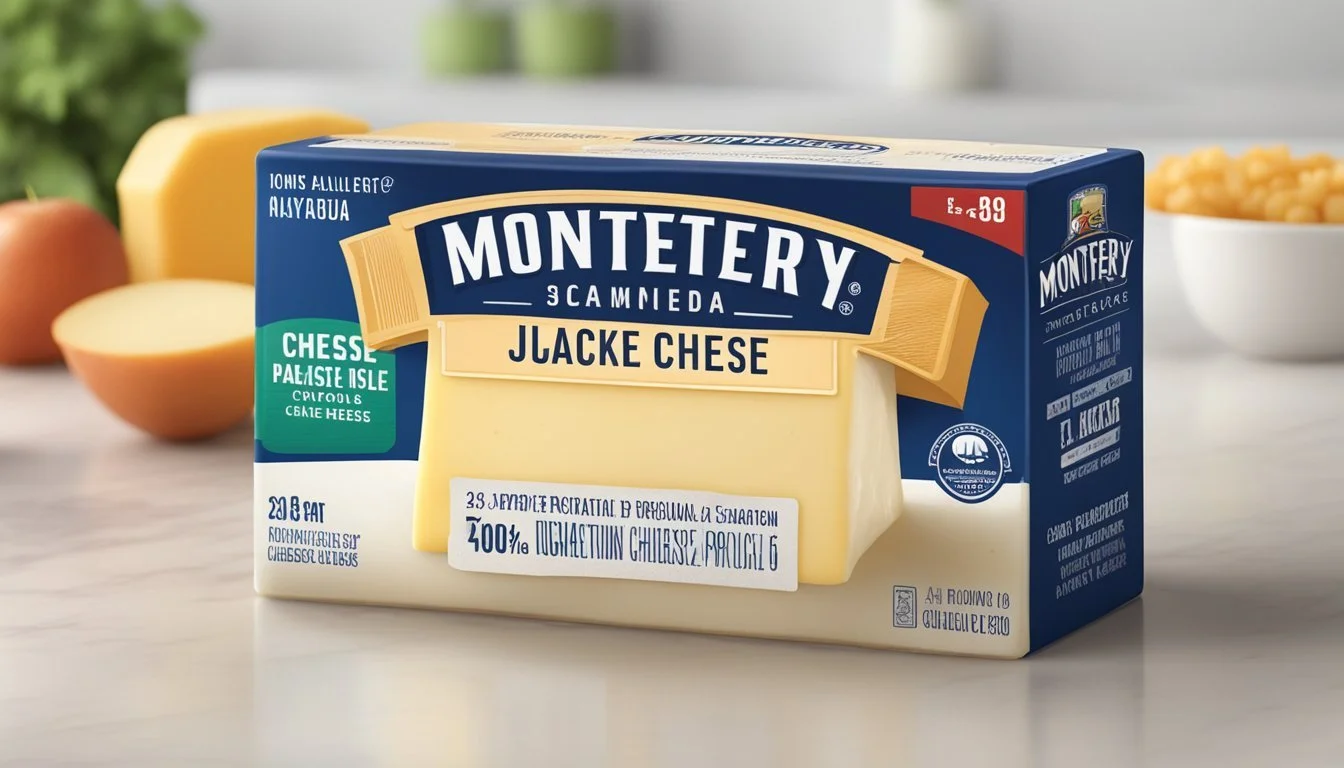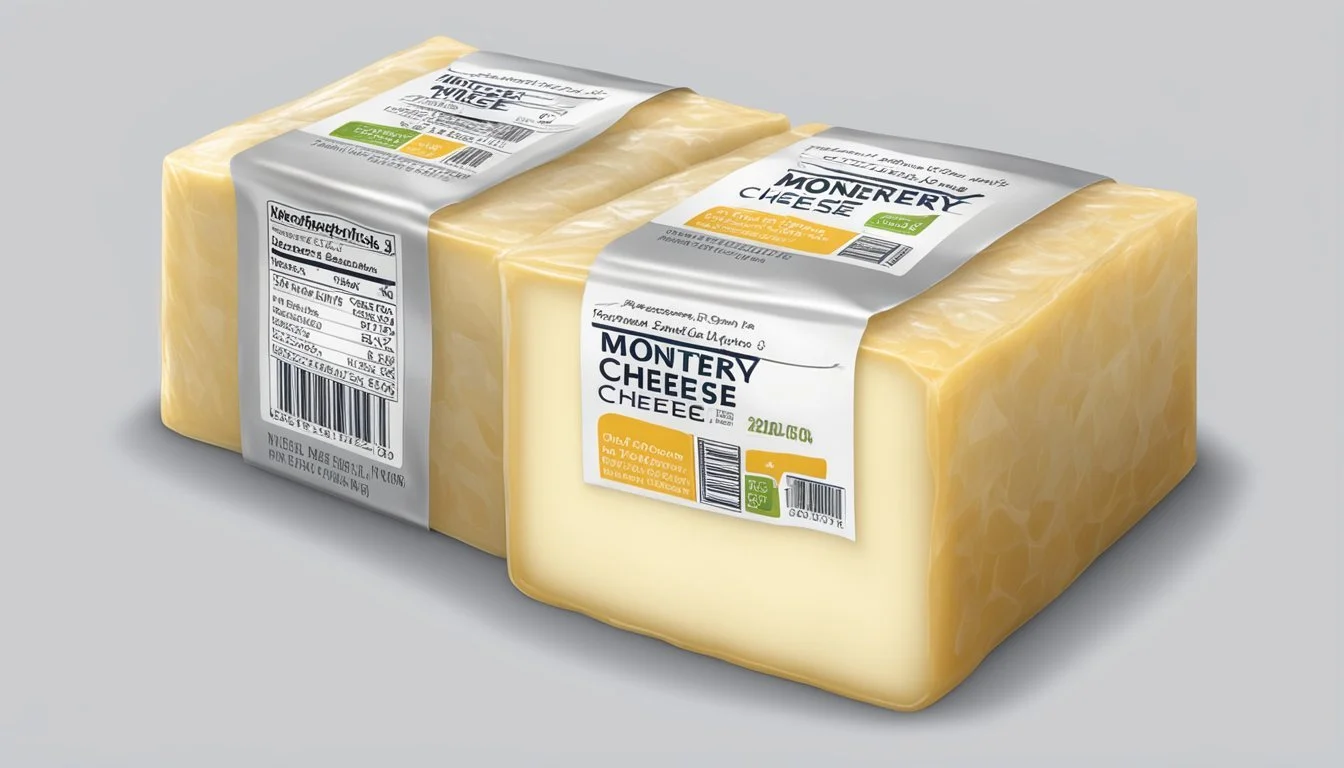How Long Does Monterey Jack Last?
Shelf Life and Storage Tips
Monterey Jack cheese, known for its mild flavor and semi-firm texture, is a popular choice among cheese enthusiasts for its versatility in cooking and snacking. Originating in California, this cheese's quality and character can vary due to factors such as moisture content and aging, with varieties including Colby Jack and Pepper Jack. When it comes to storage, the longevity of Monterey Jack cheese in its unopened state is a topic of interest for both consumers and culinary professionals.
The shelf life of unopened Monterey Jack cheese can extend up to six months under proper refrigeration, which typically means maintaining a temperature between 35°F and 45°F. At these temperatures, the growth of bacteria is inhibited, allowing the cheese to retain its desirable qualities for an extended period. The original packaging plays a crucial role in preserving the cheese's flavor and texture, and it's advisable to keep the cheese in its unopened state until ready for use to ensure maximum freshness.
Understanding Monterey Jack Cheese
Monterey Jack cheese, originating from California, is distinguished by its semi-hard texture and mild, slightly sweet flavor. It's a quintessential component in various cuisines, particularly within Mexican and American dishes. This cheese is noteworthy for its smooth texture, which makes it a versatile choice for cooking, melting, and snacking.
The production of Monterey Jack involves the use of rennet, an enzyme that helps in the coagulation of milk, a critical step in cheesemaking. The traditional recipe for this cheese has been honed over generations, reflecting California's rich dairy farming history.
Nutritional Profile: Monterey Jack cheese provides a source of essential nutrients, making it a worthwhile addition to a balanced diet. It's rich in calcium and protein, both vital for bone health and muscle maintenance.
Texture & Flavor:
Texture: Semi-hard with a smooth surface
Flavor: Mild and creamy, subtly sweet
Ideal Storage Conditions: For optimal preservation, store Monterey Jack cheese in a refrigerator set between 35°F and 45°F (1.7°C and 7.2°C). This temperature range is instrumental in slowing bacterial growth and extending the cheese's shelf life.
Monterey Jack's adaptability in recipes and presence in culinary traditions solidify its popularity. Its production and consumption have been an integral part of California's gastronomic landscape, with methods and recipes passed down and refined through the years.
Storage Guidelines
When storing Monterey Jack cheese, refrigeration is key. The optimal temperature range is 35°F to 45°F to inhibit bacteria growth and extend the cheese's usability. For unopened chunks of Monterey Jack cheese, one can expect a shelf life of about 6 months when stored properly in the refrigerator.
In the Refrigerator:
Keep the cheese in its original packaging if unopened.
Once opened, wrap the cheese tightly in plastic wrap or aluminum foil to minimize exposure to air and moisture.
For added protection, place the wrapped cheese inside an airtight container.
In the Freezer:
Although freezing is not recommended for Monterey Jack due to potential changes in texture and flavor, it is possible for extended storage.
Wrap the cheese in heavy-duty freezer bags, plastic freezer wrap, or aluminum foil before placing it in the freezer.
Maintain a consistent freezer temperature of 0°F to ensure the cheese remains frozen solid.
General Tips:
Whether refrigerating or freezing, humidity control is vital; too much moisture can lead to mold growth on the cheese.
When freezing, remove as much air as possible from the packaging to prevent freezer burn.
Consistent observance of these storage methods will help maintain the quality and longevity of Monterey Jack cheese.
Shelf Life and Spoilage Signs
Monterey Jack cheese's shelf life varies depending on its preservation method, and recognizing spoilage signs is key to preventing the consumption of a spoiled product.
Refrigerated Monterey Jack
Unopened Monterey Jack cheese can last for about 6 months in the refrigerator when kept at a consistent temperature of 40°F (4°C). Once opened, it should be consumed within 3 to 4 weeks for optimal quality.
Expiration Date: Check the "sell by," "best by," or "use by" date.
Storage Practice: Keep in its original packaging until ready to use.
Frozen Monterey Jack
Monterey Jack cheese can be frozen, extending its shelf life to beyond the usual refrigerated time frame.
Freezing Period: It retains quality for about 6 months when frozen.
Temperature: The freezer temperature should be 0°F (-18°C) or lower.
Spotting Spoilage
Recognizing when Monterey Jack has gone bad is crucial to food safety.
Mold Growth: Visible mold, not part of the original cheese-making process, indicates spoilage.
Odor: An ammonia-like or rancid smell is a clear sign the cheese is bad.
Texture: Sliminess or a change in texture suggests it's time to discard the cheese.
Safety: Even if past the "best by" date, if there are no signs of spoilage, the cheese might be safe to use, but use personal discretion.
Freezing and Defrosting
When it comes to freezing Monterey Jack cheese, it is important to know that the freshness and quality can be maintained for up to six months if properly stored. A key aspect of successful freezing is in the preparation and the defrosting process.
How to Freeze Monterey Jack
Portion: Cut the cheese into manageable portions, no larger than 1/2 pound each. This ensures that only the needed amount is defrosted, reducing waste.
Wrap: Use fresh wrap or heavy-duty aluminum foil to tightly seal each portion. This helps to prevent freezer burn and maintain quality.
Bagging: Place the wrapped cheese into a freezer bag, squeezing out as much air as possible before sealing.
Label: Write the date on the bag to keep track of the freezer time.
Freeze: Place in the freezer where the cheese will retain best quality for about six months.
Thawing Frozen Cheese
Refrigerator: Thawing Monterey Jack cheese in the refrigerator is the safest and most recommended method. Plan ahead, as this takes several hours or overnight.
Cold Water: For quicker thawing, place the cheese in a sealed bag and immerse it in cold water, changing the water every 30 minutes to ensure it remains cold.
Microwave: If immediacy is needed, one can use a microwave. Select the defrost setting, but it is crucial to use this method cautiously, as it may unevenly heat and affect the texture of the cheese.
It is important to note that once Monterey Jack has been defrosted, it should not be refrozen. To ensure the best taste and texture, it should be consumed soon after thawing.
Maintaining Quality and Freshness
Proper storage is vital to maintaining the quality and freshness of Monterey Jack cheese. This cheese thrives in a temperature range of 35°F to 45°F (1.7°C to 7.2°C), making the refrigerator an ideal spot. To prevent premature spoilage, it's important to monitor both temperature and humidity levels.
Packaging also plays a significant role in preserving Monterey Jack. Keeping the cheese in its original packaging is recommended for as long as possible. Once opened, an airtight container or plastic wrap should be used to reseal it effectively, protecting its quality from exposure to air which can lead to drying out or development of unwanted flavors.
Storage Conditions:
Refrigerator: Up to 6 months for optimal freshness
Freezer (0°F): Safe indefinitely, best used within 8 months to avoid freezer burn
Using the freezer extends the life of Monterey Jack cheese significantly. One must ensure the cheese is wrapped tightly to avoid freezer burn, which compromises taste and texture.
Here is what to remember when freezing the cheese:
Step Action 1 Wrap in aluminum foil or freezer paper. 2 Place inside a heavy-duty freezer bag. 3 Label with the current date before freezing.
By adhering to these storage guidelines, one ensures the cheese remains flavorful and clear of food safety concerns for an extended period.
Using Monterey Jack in Cooking
Monterey Jack cheese possesses a mild flavor and meltability that makes it a favorite in a variety of dishes, from classic American to Mexican cuisines.
Incorporating into Recipes
One can readily use Monterey Jack cheese in recipes calling for a smooth and mild cheese component. Widely popular in casseroles, it contributes a creamy texture without overpowering other ingredients. Chefs often sprinkle shredded Monterey Jack atop tacos and quesadillas for a quick melt and subtle taste. In salads, a few slices add a rich, but not heavy, element. With its adaptability, it is also a perfect filling for omelets and can enhance the flavor and texture of burgers and grilled cheese sandwiches.
Melting Characteristics
Monterey Jack is renowned for its excellent melting properties, making it a prime choice for cooked dishes where a uniform and smooth cheese consistency is desired. It melts evenly and well, which is why it is a go-to choice for macaroni and cheese and can create a luscious topping for pies and bakes. This cheese integrates seamlessly into sauces and soups, contributing a creamy dimension without clumping or separating when heated properly.
Substitutes for Monterey Jack
If a recipe calls for Monterey Jack and it’s not available, here are suitable substitutes that mirror its melting properties and flavor profile:
Cheddar: Sharper in taste, but melts well; use for a bolder flavor.
Mozzarella: Offers a similar consistency when melted; however, it's more stretchy and has a milder flavor.
Gouda or Young Gouda (mild gouda): Shares comparable meltability, with a slightly sweet, nutty flavor.
Colby: Similar to Monterey Jack, but a touch more tangy.
Havarti: Creamy and melts easily, a fine substitute in both hot and cold applications.
Use these alternatives depending on what the recipe intends to convey in terms of flavor and texture.
Health and Safety Considerations
When discussing Monterey Jack cheese, certain health and safety considerations must be taken into account to ensure the cheese remains safe for consumption. Monterey Jack cheese is prone to bacterial growth and mold if not stored properly. Thus, adhering to proper food storage information is crucial.
Mold Growth: If visible mold appears on the cheese, it is generally advisable to discard the affected portion. The remaining cheese should be safe to use if one cuts away at least one inch around and below the mold spot. However, it is important to check the entire cheese for signs of spoilage.
Bacterial Growth: To prevent bacterial growth, the cheese should be stored at a refrigerator temperature of around 35°F to 45°F. This temperature range slows down the proliferation of bacteria and inhibits spoilage.
Illness Prevention: Consumption of cheese that has been improperly stored or that displays signs of spoiling can lead to illness. To avoid health risks associated with spoiled cheese, one should strictly follow guidelines on when to discard cheese. If the cheese displays any discoloration, off-odor, or sliminess, it should not be consumed.
Food Storage Information:
Store in original packaging until ready to use.
Maintain a temperature between 35°F and 45°F.
Upon opening, consume within 3 weeks for optimal safety.
Applying these measures ensures Monterey Jack cheese remains a delicious and safe addition to one's diet.
Identifying and Handling an Unopened Package
When encountering an unopened package of Monterey Jack cheese, one should first check the sell by date or best by date indicated on the packaging. These dates serve as the manufacturer's estimate for peak quality. While the cheese might still be safe to consume past these dates, it's ideal to use it before the date for optimal taste and texture.
Storage Recommendations
For proper storage, the cheese should be kept refrigerated consistently at a temperature around 40°F. This cold environment helps to maintain the cheese's quality and extend its shelf life. It is important to place the Monterey Jack cheese in a part of the refrigerator where the temperature is less likely to fluctuate, such as the main shelf, rather than the door compartments.
Shelf Life and Handling
A properly stored, unopened chunk of Monterey Jack cheese can last up to six months in the refrigerator. To preserve its freshness, it is advisable not to open the package until one is ready to use the cheese.
Table: Cheese Shelf Life Overview
State of Packaging Shelf Life Storage Condition Unopened Up to 6 months Refrigerated (40°F) Opened 3 to 4 weeks Refrigerated (40°F)
Upon opening, the shelf life decreases to approximately 3 to 4 weeks under ideal refrigeration. The key to maximizing Monterey Jack cheese's longevity and quality is consistent refrigeration and minimal exposure to air and moisture until it is to be consumed.
Portioning and Preserving Leftovers
When storing leftover Monterey Jack cheese, it's essential to consider portioning and wrapping. If the cheese is in large blocks, one may cut it into smaller, more manageable pieces. These portions should not be larger than what one would typically use within a few days to maintain freshness and limit exposure to air.
Proper Wrapping for Storage:
Blocks: Wrap tightly in plastic wrap or aluminum foil. For optimal freshness, overwrap with a layer of wax paper before the plastic wrap to prevent the cheese from absorbing other odors and flavors from the refrigerator.
Shredded Cheese: Store in airtight containers or resealable plastic bags, squeezing out as much air as possible before sealing.
Ideal Conditions:
Temperature: Store at 35°F to 45°F to inhibit bacterial growth.
Humidity: A moderate level of humidity is necessary to prevent the cheese from drying out.
Shelf Life Expectancy:
Shredded Monterey Jack Cheese: Generally lasts up to 3 weeks.
Block Cheese: Once opened, it remains fresh for up to 3 to 4 weeks.
Remember, the rind of the cheese also provides natural protection and should be left intact if possible. Shredded cheese tends to go bad faster than block cheese due to its greater surface area and because it loses moisture more quickly.
For best results:
Only shred what you need.
Keep cheese separate from strong-smelling foods.
Crumbly cheese should be eaten quickly or stored according to the guidelines above to avoid spoilage.









